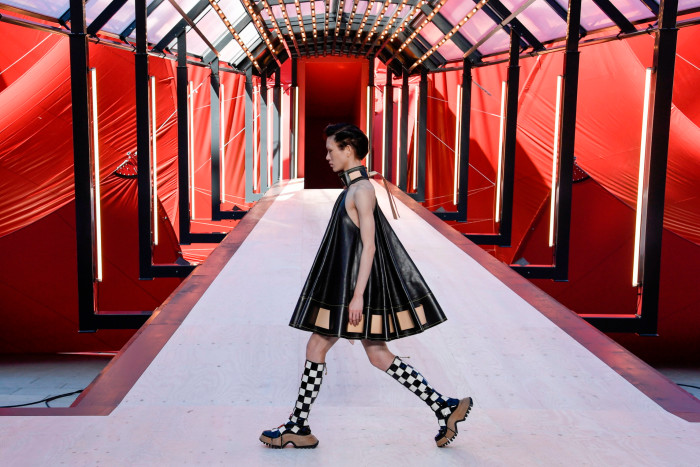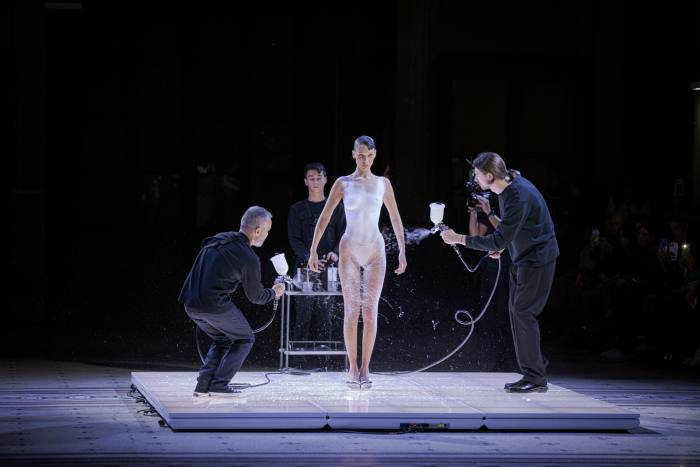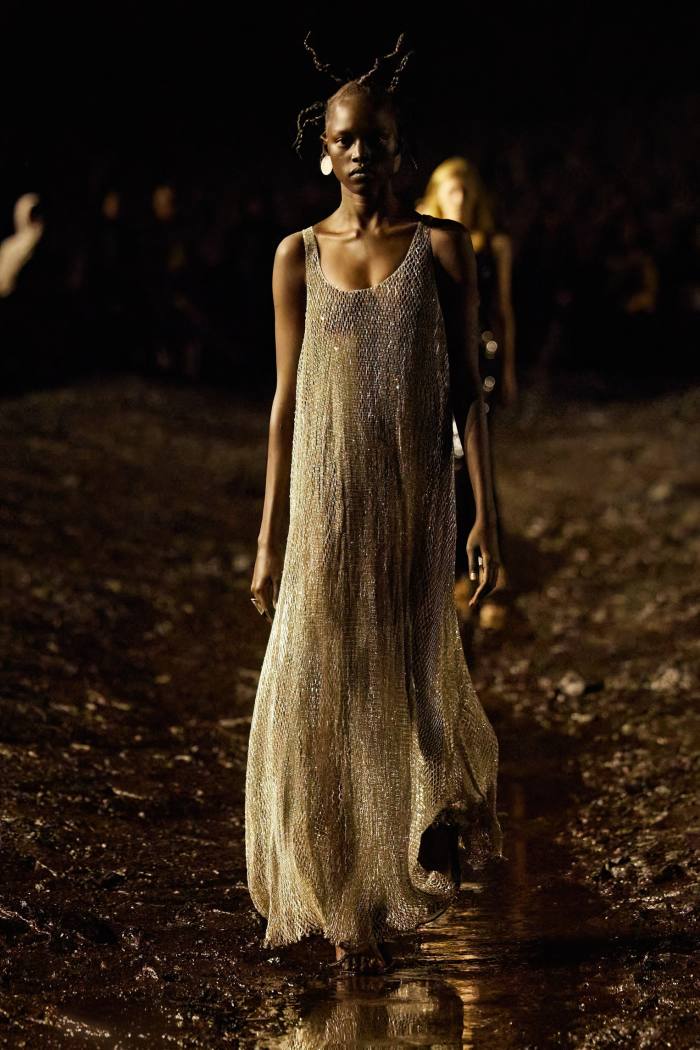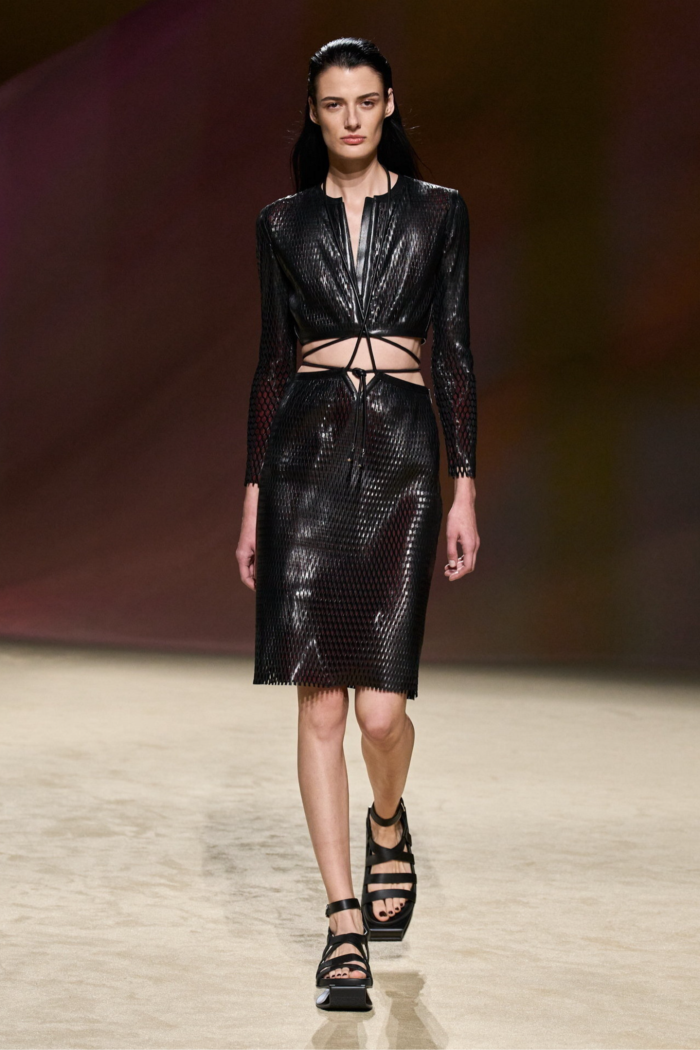
For 11 years, Kanye West has been parachuting into fashion weeks, disrupting the schedule with last-minute shows (typically to the detriment of smaller labels), and unveiling collections that have largely been torn to shreds by critics.
West did it again on the final Monday of Paris Fashion Week, three weeks after announcing that he was prematurely ending his 10-year design contract with the mass American retailer Gap and planned to terminate his longer-standing partnership with Adidas, with whom he has built a trainer business that generated $1.7bn in sales last year, according to UBS estimates. He now plans to go ahead with his own label.
Samples for that label materialised at a small show organised at short notice on the Champs-Élysées and well attended by industry power brokers, including Vogue editor Anna Wintour, Balenciaga CEO Cédric Charbit and Tiffany executive (and son of LVMH owner) Alexandre Arnault.
West’s previous shows sometimes ran hours late — in 2016 several models fainted in the heat as they waited for the show to begin — and 80 minutes behind schedule West finally appeared in a “White Lives Matter” T-shirt and bedazzled Burberry flip-flops to deliver a six-minute monologue that wove between complaints about Gap (“we were never given a factory”), bravado (“Bernard Arnault is my new Drake”, meaning that the chairman of the world’s biggest luxury group is now his chief rival) and an earnest plea for his collection to be judged fairly.

And then there were the clothes, designed by the subversive Hood by Air designer Shayne Oliver and difficult to make out in the unlit, winding hallways that made for a catwalk. There were glimpses of dark body stockings stretched over models’ faces, which gave them a frightening, alien look; puffed-up sweatshirts and down jackets of Lego-man proportions paired with skimpy vests styled as skirts; and nylon waders and moon boots that swished noisily in the semi-dark. It was a cohesive vision if not a wholly original one. More interesting were the notions of comfort and ease underpinning the clothes: everything was made to be “pull-on and pull over” with “no hardware” such as zippers or buckles, West said.
But it was the White Lives Matter shirts that became the talking point. Printed with a photo of the late Pope John Paul II on the front, they spurred more than one guest to walk out. Were they ironic? An attempt to reclaim a hate slogan? Or evidence of West’s pro-Trump political conservatism edging even further to the right? West didn’t say.

The other “viral” moment of Paris Fashion Week came, unexpectedly, from the small Parisian label Coperni. Designers Sébastien Meyer and Arnaud Vaillant sent out Bella Hadid in her knickers so that three people could spray-paint her body in a white liquid that became a dress.
The spray-on fabric was supplied by Fabrican, a London-based company that has been making the stuff for about two decades — so it wasn’t new technology. But it was new to most of the audience and those who reshared the video online, and thousands more now know the Coperni name, and associate it with innovation, because of it. Meyer and Vaillant would be smart to push that further.


Can a designer cut through without a celebrity attached? There was scant evidence of it this season. Designers seemed somewhat rudderless, caught between a spirit of post-pandemic celebration, the ongoing war in Ukraine and mounting economic fears. Escapist shows heavy on miniskirts and optimistic colours felt irrelevant and sometimes Marie Antoinette-ish; and collections too rooted in pragmatism failed to excite. No wonder so many turned to celebrities for eyeballs and relevance.
The collection that best spoke to the uncertain mood was Miu Miu, which combined dystopian futurism with clothes that were functional and desirable. “This is not an easy moment to create fashion,” designer Miuccia Prada said in her show notes. “It is important that fashion functions — I am not anti-luxury but I am anti-ostentation.”
Once referred to as Prada’s little sister, Miu Miu has grown up considerably since Miuccia began sharing creative duties at the main Prada line with Raf Simons, and is almost single-handedly responsible for reviving the trend for ultra-brief miniskirts (financially it remains a small player, with 2021 revenues of €400mn compared with Prada’s €2.9bn). This season, Miuccia worked with Berlin-based Chinese artist Li Shuang to furnish her showspace with benches modelled after the fibre-optic cables that criss-cross the sea floor, enabling 95 per cent of the world’s communications. They were a reminder of how easily disconnected we can become, both from reality and from each other. When, in January, a volcanic eruption cut through the single cable routed to Tonga, the Pacific island lost communication for five days.
From between these cable-style benches came an admirably body-diverse set of models in chalky-coloured thermal shirts delicately layered, short-sleeve rain jackets and evening dresses cut from sporty nylon, and trouser suits and top coats crafted from weathered denim and leather, as if they’d recently survived a sand-storm. In a “continuing pursuit of sustainable ideologies”, several of the leather jackets were made from pre-owned stock sourced from vintage markets, about 50 of which will go into production, the company said.


As far as sustainability agendas go, the jackets were little more than a gesture — and were undermined by a show invitation encased in two sheets of thick plastic. But at least there was a gesture. Designers at big brands hardly spoke of sustainability this season, and the lockdown-era rage for upcycling has petered out. This is partly because brands are afraid of accusations of “greenwashing”, and partly because the novelty of deadstock and certified-sustainable fabrics has worn off. Or at least talking about it has.
Of course Stella McCartney did want to talk about it, announcing backstage that her collection was her “most sustainable yet”, with 87 per cent of it made from “conscious materials” such as solvent-free rhinestones, regenerative cotton and “grape-based” faux leathers. The materials are continuing to evolve, but the design needs to too — McCartney could do with taking a few more risks.


Balenciaga’s Demna Gvasalia also revisited well-trodden territory, both with his set (a mud pit, only this time without the snow) and his clothes (tracksuits, oversized tailoring, a pleated cape-back dress).
The same applies to Nadège Vanhee-Cybulski’s shows for Hermès, where clean leather separates and sporty tailoring are always on the menu. And to Virginie Viard at Chanel, who has softened the line of the house’s tweed suits and dresses and given new emphasis to jewellery but done little to evolve or challenge the house codes.
Strategically, there is a logic to keeping it classic at these labels. Both produce handbags that double as investments — a Hermès bag set a new record of €352,800 at Sotheby’s last week — and clients can feel safe buying from designers who don’t rock the boat. But the brands also need to stay fresh.
Nicolas Ghesquière’s collections for Louis Vuitton have their own formula, regularly combining femininity and sport, futurism and traditional leather savoir-faire. What keeps them alive is their constant and often daring play on proportion, and here he took details of the brand’s leather goods — zippers and pull-tabs, locks and labels, even the corner piece of a trunk — and blew them up into belts, sleeves and sometimes full garments. The razzle-dazzle sets help too: this was a sort of red-and-gold marquee designed by installation artist Philippe Parreno in the shape of a flower and installed in the central courtyard of the Louvre. When it comes to cutting through, deep pockets also help.
Lauren Indvik is the FT’s fashion editor
Find out about our latest stories first — follow @financialtimesfashion on Instagram







